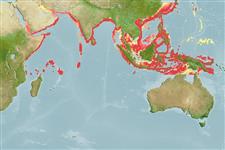Preferred temperature (Ref.
115969): 16.8 - 26, mean 21.2 (based on 405 cells).
Phylogenetic diversity index (Ref.
82804): PD
50 = 0.5312 [Uniqueness, from 0.5 = low to 2.0 = high].
Bayesian length-weight: a=0.00417 (0.00323 - 0.00537), b=3.14 (3.07 - 3.21), in cm Total Length, based on LWR estimates for this species (Ref.
93245).
Τροφικό Επίπεδο (Ref.
69278): 4.1 ±0.74 se; based on food items.
Ελαστικότητα (Ref.
120179): Υψηλό, ελάχιστος χρόνος για διπλασιασμό πληθυσμού < 15 μήνες (K=0.18-0.9; Fec=89,600).
Prior r = 1.16, 95% CL = 0.77 - 1.75, Based on 5 data-limited stock assessments.
Fishing Vulnerability (Ref.
59153): Low to moderate vulnerability (26 of 100).
Climate Vulnerability (Ref.
125649): Moderate to high vulnerability (53 of 100).
